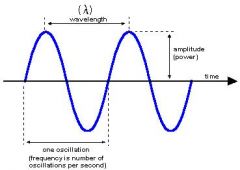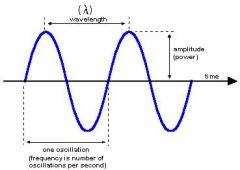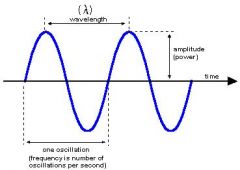![]()
![]()
![]()
Use LEFT and RIGHT arrow keys to navigate between flashcards;
Use UP and DOWN arrow keys to flip the card;
H to show hint;
A reads text to speech;
53 Cards in this Set
- Front
- Back
|
WISP
|
Wireless ISP
|
|
|
absorption
|
occurs when the RF signal strikes an object and is absorbed (does not pass through, reflect, or bend)
CWNA studies |
|
|
amplitude
|

The strength or volume of a signal, usually measured in decibels.
http://answers.com |
|
|
frequency
|

number of oscillations per second
http://answers.com |
|
|
wavelength
|

Distance between waves.
-- The distance between the top of one wave and the identical phase of the succeeding one in the advance of waves of radiant energy. http://answers.com |
|
|
phase
|
Phase is a method of experessing the relationship between the amplitudes of two RF signals that have teh same frequency. Phase is measured in degrees (like a compass...)
CWNA studes |
|
|
gain
|
an increase in signal power
(amplification) |
|
|
Antenna Gain
|
measure of the effectiveness of a directional antenna as compared to a nondirectional antenna.
|
|
|
Loss
|
Attenuation - loss in signal power (loss of amplitude)
|
|
|
Reflection
|
name is self-explanatory - can lead to multipath. (lakes, metal roofs, metal blinds, metal doors, etc)
|
|
|
Refraction
|
bending of radio wave as passes through medium of different density.
CWNA studies |
|
|
Diffraction
|
describes a wave bending around an obstacle
|
|
|
Scattering
|
Can be thought of as lots of little reflections. Normally caused by rough surfaces or heavy particles in air.
CWNA p.38 |
|
|
VSWR
|
Voltage Standing Wave Ratio - occurs when there is mismatched impedence(measured in Ohms). Most impedance is 50 ohms on today's devices.
|
|
|
Return Loss
|
defined as the loss of forward energy through a system due to some of the power being reflected back toward the transmitter. VSWR causes this.
CWNA page 39 |
|
|
Wave Propagation
|
is any of the ways in which waves travel through a medium.
http://answers.com |
|
|
Polarization
|
A radio wave is actually made up of two fields, one electric and one magnetic. The two fields are on planes perpendcular to each other,
Polorization is the physical orientation of the antenna...IF the antenna is vertical, then the polarization is vertical. etc. |
|
|
Intentional Radiator
|
an RF device specifically designed to generate and radiate RF signals. (all components - except antenna).
CWNA p 41 |
|
|
EIRP
|
Equivalent Isotropically Radiated Power -- the power actually ratdiated by the antenna element (includes gain of antenna).
CWNA - p 42 |
|
|
Watt
|
basic unit of power. one amp flowing at one volt.
amps x volts also equal to one joule/second. http://answers.com |
|
|
Milliwatt
|
1/1,000th of a watt
|
|
|
Decibel (dB)
|
a decibel always measures the relative strength between two signals. CWNA-p51
A unit of measurement of the loudness or strength of a signal. One deciBel is considered the smallest difference in sound level that the human ear can discern. Created in the early days of telephony as a way to measure cable and equipment performance and named after Alexander Graham Bell, deciBels (dBs) are a relative measurement derived from two signal levels: a reference input level and an observed output level. A deciBel is the logarithm of the ratio of the two levels. One Bel is when the output signal is 10x that of the input, and one deciBel is 1/10th of a Bel. A whisper is about 20 dB. A normal conversation is typically from 60 to 70 dB, and a noisy factory from 90 to 100 dB. Loud thunder is approximately 110 dB, and 120 dB borders on the threshold of pain. http://answers.com |
|
|
dBm
|
A measurement of power loss in decibels using 1 milliwatt as the reference point. http://answers.com
(also see CWNA studies p55-58) |
|
|
dBi
|
The measurement of GAIN a directional antenna compared with a THEORETICAL "isotropic antenna," which radiates the exact same energy in all directions.
http://answers.com |
|
|
dBd
|
measuers the GAN of a reall antenna relative to a theoretical half-wave dpole antenna.
"standard" antenna used for dBd measuerement is a half-wave dipole with a gain of 2.14 dBi. dBd can be converted to dBi by adding 2.14. |
|
|
RSSI
|
Received Singal Strength Indicator
|
|
|
rules of tens and threes
|
+10 dB = x10 power
-10 dB = /10 power +3 dB = x2 power -3 dB = /2 power |
|
|
Isotropic Radiator
|
In antenna theory, the isotropic radiator is a theoretical radiator having a directivity of 0 dBi (dB relative to isotropic), which means that the radiator equally transmits (or receives) electromagnetic radiation from any arbitrary direction. http://answers.com
hairball theory (perfect smooth surface not possible) |
|
|
Fresnel Zone
|
fra-NEL zone
The Fresnel zone is one of a (theoretically infinite) number of a concentric ellipsoids of revolution which define volumes in the radiation pattern of a (usually) circular aperture. The concept of Fresnel zones may also be used to analyze interference by obstacles near the path of a radio beam. The first zone must be kept largely free from obstructions to avoid interfering with the radio reception. However, some obstruction of the Fresnel zones can often be tolerated, as a rule of thumb the maximum obstruction allowable is 40%, but the recommended obstruction is 20% or less. http://answers.com |
|
|
Beamwidths
|
Typically, beamwidth is calculated by measuering th enumber of degrees off-axis where the beam drops to 1/2 (or 3dB) its strenght at the zero-degree position. Vertical and Horizontal
|
|
|
Azimuth & Elevation
|
Azimuth = top-down view of antenna's coverage
Elevation = side-view CWNA page80-81 |
|
|
Passive Gain
|
Power increase made by focusing direction of signal
CWNA p.132 |
|
|
Omni-Directional
|
Energy is radiated equally in all directions.
Dipole Antennas most common for wi-fi. TV rabbit ears is another example. |
|
|
Semi-Directional Antennas
|
Patch, Panel, Yagi
|
|
|
Highly Directional antennas
|
Parabolic and Grid
|
|
|
Phased-Array antennas
|
Advanced "Smart" Antennas - individual signals can be adjusted, each pointing in a different direction.
CWNA - p.127 |
|
|
Sector Antennas
|
flat wide radiation pattern (60-180 degrees) advantage=can be placed back to back, because lobes are small behind antenna. CWNA p.113
|
|
|
System Operating Margin
|
Link Budget
|
|
|
Fade Margin
|
The amount by which a received signal level may be reduced without causing system performance to fall below a specified threshold value.
|
|
|
Link Budget
|
is the accounting of all of the gains and losses from the transmitter, through the medium (free space, cable, waveguide, fiber, etc.) to the receiver in a telecommunication system. It takes into account the attenuation of the transmitted signal due to propagation, as well as the loss, or gain, due to the antenna. Random attenuations such as fading are not taken into account in link budget calculations with the assumption that fading will be handled with diversity techniques. http://answers.com
|
|
|
The 6dB Rule
|
Each 6 dB increase in EIRP equaes to a doubling of range. (each 6dB reduction = 1/2 range)
|
|
|
FSL: Free Space Loss
|

single greatest source of loss incurred by an RF signal due to "signal dispersion", which is a natural broadening of the wave front. CWNA p.96
|
|
|
Earth Bulge
|
Distance between antennas will cause the Fresnel Zone to increase in size, and to be obstructed. Raise Antenna. Fresnel Zone must be at least 60 percent clear (optimally at least 80%). CWNA p.95
|
|
|
Insertion Loss
|
The loss in load power due to the insertion of a component or device (in dB).
|
|
|
Transient Current
|
needs definition
|
|
|
Frequency Converter
|
device for converting a freq range to another (i.e. 2.4 -> 5). placed between antenna and trans\receiver.
|
|
|
FHSS
|
Frequency Hopping Spread Spectrum
|
|
|
DSSS
|
Direct Sequence Spread Spectrum -- is a modulation technique.
DSSS transmissions multiply the data being transmitted by a "noise" signal. This noise signal is a pseudorandom sequence of 1 and −1 values, at a frequency much higher than that of the original signal, thereby spreading the energy of the original signal into a much wider band. The resulting signal resembles white noise, like an audio recording of "static". However, this noise-like signal can be used to exactly reconstruct the original data at the receiving end, |
|
|
OFDM
|
Othorgonal Frequency Division Multiplexing
|
|
|
Dwell time and Hop time
|
used in FHSS.
DWELL time=time on freq.(milli-seconds). HOP time=time between freq. (micro-seconds) |
|
|
Benifits of DSSS
|
***Resistance to intended or unintended jamming.
***Sharing of a single channel among multiple users. ***Determination of relative timing between transmitter and receiver. |
|
|
Uses of DSSS
|
***The United States GPS, Russian Glonass, and European ***Galileo satellite navigation systems.
***CDMA cellular phones. ***Cordless phones operating in the 2.4 and 5.8 GHz bands. ***The 802.11 and 802.11b Wi-Fi standards. (The faster modes in 802.11g use OFDM, not spread spectrum, although it can fall back to the slower 802.11b modes.) ***ZigBee / 802.15.4 ***Automatic meter reading |
|
|
AFH
|
Adaptive Frequency-hopping spread spectrum (AFH) (as used in Bluetooth) improves resistance to radio frequency interference by avoiding using crowded frequencies in the hopping sequence. This sort of adaptive modulation is easier to implement with FHSS than with DSSS.
|

